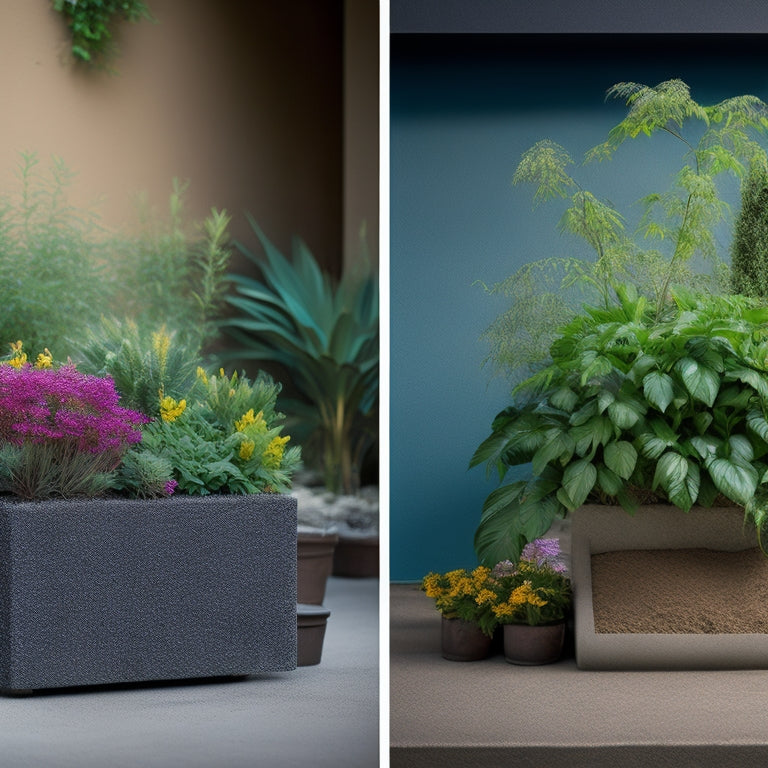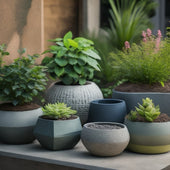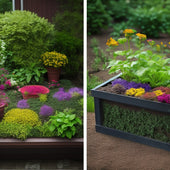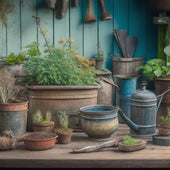
Why Cinder Block Planter Boxes Need Irrigation Systems
Share
When you build a cinder block planter box, you're fundamentally creating a water-repellent container that requires a careful balance of moisture and drainage to support healthy plant growth. Cinder blocks' porous nature, dense material, and evaporation lead to inconsistent moisture retention, surface pooling, and waterlogged soil, causing root rot. Without proper irrigation, soil erosion and nutrient loss will occur, reducing plant growth and yield. By incorporating an irrigation system, you'll counteract these challenges, ensuring ideal oxygen availability, nutrient supply, and aesthetic appeal. As you explore further, you'll discover the intricacies of designing an effective irrigation system that meets your plants' unique needs.
Key Takeaways
• Cinder block planters require irrigation systems to prevent waterlogging and root rot due to their porous nature and slow water absorption.
• Effective irrigation prevents soil erosion and nutrient loss, ensuring healthy plant growth and optimal nutrient availability.
• Irrigation systems maintain ideal soil moisture levels (40-60%) and oxygen availability (10-20%) for plants to thrive in cinder block planters.
• Without irrigation, cinder block planters are prone to stagnant water, leading to root rot and reduced plant growth, making irrigation systems essential.
• Irrigation systems in cinder block planters enhance aesthetic appeal, allowing for diverse plant displays and unique visual identities in landscaping.
Watering Challenges in Cinder Blocks
When building a cinder block planter box, you'll quickly discover that the block's porous nature and dense material composition create a unique set of watering challenges.
Water seeps through the block's tiny pores, making it difficult to maintain ideal moisture levels. This can lead to overwatering, which results in waterlogged soil and root rot. On the other hand, the dense material composition of cinder blocks slows down water absorption, causing water to pool on the surface. This can lead to water loss through evaporation, making it challenging to achieve consistent moisture retention.
To overcome these challenges, it's crucial to implement effective drainage solutions. You can do this by adding a layer of gravel or broken pottery at the bottom of the planter box to facilitate water flow.
Additionally, incorporating a moisture-retentive material, such as peat moss or coconut coir, into your soil mix can help regulate water absorption and retention.
Soil Erosion and Nutrient Loss
How do you prevent soil erosion and nutrient loss in your cinder block planter box, where the porous nature of the blocks and gravity can conspire against you, washing away precious soil and nutrients?
To maintain ideal soil health, you need to address soil compaction. When you water your plants, the soil can become compacted, reducing its ability to absorb and retain moisture. This can lead to erosion and nutrient loss. To combat this, incorporate organic matter like compost or well-rotted manure into your soil. This will improve its structure, allowing it to retain more moisture and reducing the likelihood of erosion.
Proper irrigation systems can also help reduce soil erosion. By delivering water directly to the roots of your plants, you minimize surface runoff and prevent water from flowing out of the planter box. This guarantees that your soil receives the right amount of moisture, reducing the risk of erosion and nutrient loss.
Additionally, consider using a mulch or groundcover to help retain moisture in the soil and prevent erosion. By taking these steps, you can maintain healthy, nutrient-rich soil in your cinder block planter box.
Reduced Plant Growth and Yield
By enhancing soil health and minimizing erosion, you've set the stage for your plants to thrive, but even with these precautions, reduced plant growth and yield can still occur if your cinder block planter box lacks adequate aeration and drainage. Insufficient aeration can lead to oxygen deprivation, hindering plant health and growth. Poor drainage, on the other hand, can cause waterlogged soil, reducing the availability of essential nutrients. This can greatly impact plant growth and yield.
| Growth Factor | Ideal Range | Impact on Plant Growth |
|---|---|---|
| Oxygen Availability | 10-20% | Reduced oxygen availability can lead to stunted growth and decreased yields. |
| Soil Moisture | 40-60% | Waterlogged soil can lead to oxygen deprivation and nutrient deficiency. |
| Nutrient Availability | 10-50 ppm | Insufficient nutrients can limit plant growth and development. |
| Soil Temperature | 15-25°C | Temperature extremes can impact nutrient uptake and plant growth. |
| pH Levels | 6.0-7.0 | Imbalanced pH levels can affect nutrient availability and plant health. |
Increased Risk of Root Rot
In poorly draining cinder block planter boxes, stagnant water and oxygen-deprived soil create an ideal environment for root rot to take hold, putting your plants at risk of devastating damage.
When water accumulates in the soil, it reduces the oxygen available to the roots, causing them to suffocate. This sets the stage for root rot to develop, leading to a decline in root health and ultimately, plant death.
You can identify root rot by its characteristic symptoms, including:
-
Soft, mushy stems
-
Wilting or yellowing leaves
-
A sour or unpleasant odor emanating from the soil
- Visible fungal growth on the soil surface or plant stems
To prevent root rot, it's crucial to guarantee good drainage and aeration in your cinder block planter boxes.
An irrigation system can help regulate moisture retention, preventing waterlogged soil and promoting healthy root growth.
Enhanced Aesthetic Appeal Benefits
Cinder block planter boxes, when designed with an irrigation system, transform into visually stunning focal points that elevate the beauty of your outdoor space. With an irrigation system, you can confidently choose a wider range of plants, knowing they'll receive the right amount of water. This freedom of choice leads to a more diverse and vibrant display of colors, textures, and forms, giving you greater design versatility. You can mix and match different plant species, creating a unique visual identity for your outdoor space.
The incorporation of an irrigation system also allows you to focus on the aesthetic aspects of your planter box design. You can choose from a variety of color options for your cinder blocks, such as painted or stained finishes, to complement your outdoor decor. Additionally, the irrigation system's sleek and discreet design guarantees that it won't detract from the visual appeal of your planters.
With an irrigation system, you can create a beautiful and thriving outdoor oasis that reflects your personal style and design preferences. By combining functionality with aesthetics, you'll be able to enjoy a stunning and low-maintenance outdoor space that you'll love spending time in.
Frequently Asked Questions
Can I Use a Drip Irrigation System in My Cinder Block Planter?
You're considering a drip irrigation system for your cinder block planter, which is a great idea! This type of system offers several benefits, including targeted watering and reduced evaporation.
When designing your planter box, keep in mind that drip systems work best with row crops or plants spaced closely together. You'll need to layout the tubes and emitters strategically to guarantee each plant receives the right amount of water.
With a well-planned drip system, you'll be in control of your plants' hydration and enjoy ideal growth.
How Often Should I Water My Cinder Block Planter Box?
You're probably thinking you need to water your cinder block planter box every hour on the hour, but relax, that's not necessary!
In reality, the ideal watering frequency depends on the soil's moisture retention. Check the soil daily, and water only when the top 2-3 inches feel dry.
For most plants, this translates to watering every 2-3 days in the summer and every 4-5 days in the spring and fall.
Get it just right, and your plants will thrive!
Are There Any Specific Irrigation Timers I Should Use?
When selecting an irrigation timer for your cinder block planter box, you'll want one that's compatible with your digital irrigation system.
Look for timers with multiple start times and intervals to customize watering schedules.
Opt for a timer with a large, clear display and intuitive interface for easy programming.
Consider a timer with Wi-Fi connectivity for remote access and smartphone app control.
This level of precision will give you complete control over your plants' hydration.
Can I Automate My Cinder Block Planter's Irrigation System?
You can definitely automate your cinder block planter's irrigation system.
To do this, you'll need to install a timer that triggers watering based on specific conditions.
Consider using moisture sensors to monitor soil moisture levels and adjust watering schedules accordingly.
This automated watering system will guarantee your plants receive the right amount of water, exactly when they need it.
With this setup, you'll have complete control over your planter's hydration, and your plants will thrive as a result.
Do I Need to Adjust Irrigation Based on Plant Type and Climate?
As you design your irrigation system, you'll need to take into account the specific plant water requirements and climate moisture considerations.
You'll want to adjust your irrigation schedule based on the unique needs of each plant type. For instance, succulents require less water than ferns, and plants in dry climates need more frequent watering.
Conclusion
As you gaze upon your cinder block planter box, teeming with life, it's easy to overlook the hidden struggles beneath the surface.
But without an irrigation system, your plants are constantly on the brink of disaster, battling soil erosion, nutrient loss, and root rot.
Yet, with a well-designed irrigation system, your plants will thrive, and your cinder block planter box will transform into a vibrant oasis, where beauty and functionality converge in perfect harmony.
Related Posts
-

5 Best DIY Planter Ideas to Upcycle Concrete
You're about to breathe new life into discarded concrete blocks by transforming them into functional and visually app...
-

5 Best DIY Planter Ideas to Upcycle Concrete
You're about to breathe new life into discarded concrete blocks by transforming them into functional and visually app...
-

5 Best DIY Planter Ideas to Upcycle Concrete
You're about to breathe new life into discarded concrete blocks by transforming them into functional and visually app...
-

5 Best DIY Planter Ideas to Upcycle Concrete
You're about to breathe new life into discarded concrete blocks by transforming them into functional and visually app...
-

5 Best DIY Planter Ideas to Upcycle Concrete
You're about to breathe new life into discarded concrete blocks by transforming them into functional and visually app...
-

5 Best DIY Planter Ideas to Upcycle Concrete
You're about to breathe new life into discarded concrete blocks by transforming them into functional and visually app...
-

5 Best DIY Planter Ideas to Upcycle Concrete
You're about to breathe new life into discarded concrete blocks by transforming them into functional and visually app...
-

5 Best DIY Planter Ideas to Upcycle Concrete
You're about to breathe new life into discarded concrete blocks by transforming them into functional and visually app...
-

5 Best DIY Planter Ideas to Upcycle Concrete
You're about to breathe new life into discarded concrete blocks by transforming them into functional and visually app...
-

5 Best DIY Planter Ideas to Upcycle Concrete
You're about to breathe new life into discarded concrete blocks by transforming them into functional and visually app...
-

5 Best DIY Planter Ideas to Upcycle Concrete
You're about to breathe new life into discarded concrete blocks by transforming them into functional and visually app...
-

5 Best DIY Planter Ideas to Upcycle Concrete
You're about to breathe new life into discarded concrete blocks by transforming them into functional and visually app...
-

5 Best DIY Planter Ideas to Upcycle Concrete
You're about to breathe new life into discarded concrete blocks by transforming them into functional and visually app...
-

5 Best DIY Planter Ideas to Upcycle Concrete
You're about to breathe new life into discarded concrete blocks by transforming them into functional and visually app...
-

5 Best DIY Planter Ideas to Upcycle Concrete
You're about to breathe new life into discarded concrete blocks by transforming them into functional and visually app...
-

5 Best DIY Planter Ideas to Upcycle Concrete
You're about to breathe new life into discarded concrete blocks by transforming them into functional and visually app...
-

5 Best DIY Planter Ideas to Upcycle Concrete
You're about to breathe new life into discarded concrete blocks by transforming them into functional and visually app...
-

5 Best DIY Planter Ideas to Upcycle Concrete
You're about to breathe new life into discarded concrete blocks by transforming them into functional and visually app...
-

Soil Selection for Successful Planter Garden Boxes
When selecting soil for your planter garden box, it's important to balance drainage, moisture retention, and nutrient...
-

Soil Selection for Successful Planter Garden Boxes
When selecting soil for your planter garden box, it's important to balance drainage, moisture retention, and nutrient...
-

Soil Selection for Successful Planter Garden Boxes
When selecting soil for your planter garden box, it's important to balance drainage, moisture retention, and nutrient...
-

Soil Selection for Successful Planter Garden Boxes
When selecting soil for your planter garden box, it's important to balance drainage, moisture retention, and nutrient...
-

Soil Selection for Successful Planter Garden Boxes
When selecting soil for your planter garden box, it's important to balance drainage, moisture retention, and nutrient...
-

Soil Selection for Successful Planter Garden Boxes
When selecting soil for your planter garden box, it's important to balance drainage, moisture retention, and nutrient...
-

Soil Selection for Successful Planter Garden Boxes
When selecting soil for your planter garden box, it's important to balance drainage, moisture retention, and nutrient...
-

Soil Selection for Successful Planter Garden Boxes
When selecting soil for your planter garden box, it's important to balance drainage, moisture retention, and nutrient...
-

Soil Selection for Successful Planter Garden Boxes
When selecting soil for your planter garden box, it's important to balance drainage, moisture retention, and nutrient...
-

Soil Selection for Successful Planter Garden Boxes
When selecting soil for your planter garden box, it's important to balance drainage, moisture retention, and nutrient...
-

Soil Selection for Successful Planter Garden Boxes
When selecting soil for your planter garden box, it's important to balance drainage, moisture retention, and nutrient...
-

Soil Selection for Successful Planter Garden Boxes
When selecting soil for your planter garden box, it's important to balance drainage, moisture retention, and nutrient...
-

Soil Selection for Successful Planter Garden Boxes
When selecting soil for your planter garden box, it's important to balance drainage, moisture retention, and nutrient...
-

Soil Selection for Successful Planter Garden Boxes
When selecting soil for your planter garden box, it's important to balance drainage, moisture retention, and nutrient...
-

Soil Selection for Successful Planter Garden Boxes
When selecting soil for your planter garden box, it's important to balance drainage, moisture retention, and nutrient...
-

Soil Selection for Successful Planter Garden Boxes
When selecting soil for your planter garden box, it's important to balance drainage, moisture retention, and nutrient...
-

Soil Selection for Successful Planter Garden Boxes
When selecting soil for your planter garden box, it's important to balance drainage, moisture retention, and nutrient...
-

Soil Selection for Successful Planter Garden Boxes
When selecting soil for your planter garden box, it's important to balance drainage, moisture retention, and nutrient...
-

Soil Selection for Successful Planter Garden Boxes
When selecting soil for your planter garden box, it's important to balance drainage, moisture retention, and nutrient...
-

Soil Selection for Successful Planter Garden Boxes
When selecting soil for your planter garden box, it's important to balance drainage, moisture retention, and nutrient...
-

Soil Selection for Successful Planter Garden Boxes
When selecting soil for your planter garden box, it's important to balance drainage, moisture retention, and nutrient...
-

Soil Selection for Successful Planter Garden Boxes
When selecting soil for your planter garden box, it's important to balance drainage, moisture retention, and nutrient...
-

Soil Selection for Successful Planter Garden Boxes
When selecting soil for your planter garden box, it's important to balance drainage, moisture retention, and nutrient...
-

Soil Selection for Successful Planter Garden Boxes
When selecting soil for your planter garden box, it's important to balance drainage, moisture retention, and nutrient...
-

Soil Selection for Successful Planter Garden Boxes
When selecting soil for your planter garden box, it's important to balance drainage, moisture retention, and nutrient...
-

Soil Selection for Successful Planter Garden Boxes
When selecting soil for your planter garden box, it's important to balance drainage, moisture retention, and nutrient...
-

Soil Selection for Successful Planter Garden Boxes
When selecting soil for your planter garden box, it's important to balance drainage, moisture retention, and nutrient...
-

Soil Selection for Successful Planter Garden Boxes
When selecting soil for your planter garden box, it's important to balance drainage, moisture retention, and nutrient...
-

Soil Selection for Successful Planter Garden Boxes
When selecting soil for your planter garden box, it's important to balance drainage, moisture retention, and nutrient...
-

Soil Selection for Successful Planter Garden Boxes
When selecting soil for your planter garden box, it's important to balance drainage, moisture retention, and nutrient...
-

Soil Selection for Successful Planter Garden Boxes
When selecting soil for your planter garden box, it's important to balance drainage, moisture retention, and nutrient...
-

Soil Selection for Successful Planter Garden Boxes
When selecting soil for your planter garden box, it's important to balance drainage, moisture retention, and nutrient...
-

Inspect and Revive Second-Hand Tools for Planters
When inspecting and reviving second-hand tools for planters, prioritize tools with sturdy builds and functional parts...
-

Inspect and Revive Second-Hand Tools for Planters
When inspecting and reviving second-hand tools for planters, prioritize tools with sturdy builds and functional parts...
-

Inspect and Revive Second-Hand Tools for Planters
When inspecting and reviving second-hand tools for planters, prioritize tools with sturdy builds and functional parts...
-

Inspect and Revive Second-Hand Tools for Planters
When inspecting and reviving second-hand tools for planters, prioritize tools with sturdy builds and functional parts...
-

Inspect and Revive Second-Hand Tools for Planters
When inspecting and reviving second-hand tools for planters, prioritize tools with sturdy builds and functional parts...
-

Inspect and Revive Second-Hand Tools for Planters
When inspecting and reviving second-hand tools for planters, prioritize tools with sturdy builds and functional parts...
-

Inspect and Revive Second-Hand Tools for Planters
When inspecting and reviving second-hand tools for planters, prioritize tools with sturdy builds and functional parts...
-

Inspect and Revive Second-Hand Tools for Planters
When inspecting and reviving second-hand tools for planters, prioritize tools with sturdy builds and functional parts...
-

Inspect and Revive Second-Hand Tools for Planters
When inspecting and reviving second-hand tools for planters, prioritize tools with sturdy builds and functional parts...
-

Inspect and Revive Second-Hand Tools for Planters
When inspecting and reviving second-hand tools for planters, prioritize tools with sturdy builds and functional parts...
-

Inspect and Revive Second-Hand Tools for Planters
When inspecting and reviving second-hand tools for planters, prioritize tools with sturdy builds and functional parts...
-

Inspect and Revive Second-Hand Tools for Planters
When inspecting and reviving second-hand tools for planters, prioritize tools with sturdy builds and functional parts...
-

Inspect and Revive Second-Hand Tools for Planters
When inspecting and reviving second-hand tools for planters, prioritize tools with sturdy builds and functional parts...
-

Inspect and Revive Second-Hand Tools for Planters
When inspecting and reviving second-hand tools for planters, prioritize tools with sturdy builds and functional parts...
-

Inspect and Revive Second-Hand Tools for Planters
When inspecting and reviving second-hand tools for planters, prioritize tools with sturdy builds and functional parts...
-

Inspect and Revive Second-Hand Tools for Planters
When inspecting and reviving second-hand tools for planters, prioritize tools with sturdy builds and functional parts...
-

Inspect and Revive Second-Hand Tools for Planters
When inspecting and reviving second-hand tools for planters, prioritize tools with sturdy builds and functional parts...
-

Inspect and Revive Second-Hand Tools for Planters
When inspecting and reviving second-hand tools for planters, prioritize tools with sturdy builds and functional parts...
-

Inspect and Revive Second-Hand Tools for Planters
When inspecting and reviving second-hand tools for planters, prioritize tools with sturdy builds and functional parts...
-

Inspect and Revive Second-Hand Tools for Planters
When inspecting and reviving second-hand tools for planters, prioritize tools with sturdy builds and functional parts...
-

Inspect and Revive Second-Hand Tools for Planters
When inspecting and reviving second-hand tools for planters, prioritize tools with sturdy builds and functional parts...
-

Inspect and Revive Second-Hand Tools for Planters
When inspecting and reviving second-hand tools for planters, prioritize tools with sturdy builds and functional parts...
-

Inspect and Revive Second-Hand Tools for Planters
When inspecting and reviving second-hand tools for planters, prioritize tools with sturdy builds and functional parts...
-

Inspect and Revive Second-Hand Tools for Planters
When inspecting and reviving second-hand tools for planters, prioritize tools with sturdy builds and functional parts...
-

Inspect and Revive Second-Hand Tools for Planters
When inspecting and reviving second-hand tools for planters, prioritize tools with sturdy builds and functional parts...
-

Inspect and Revive Second-Hand Tools for Planters
When inspecting and reviving second-hand tools for planters, prioritize tools with sturdy builds and functional parts...


